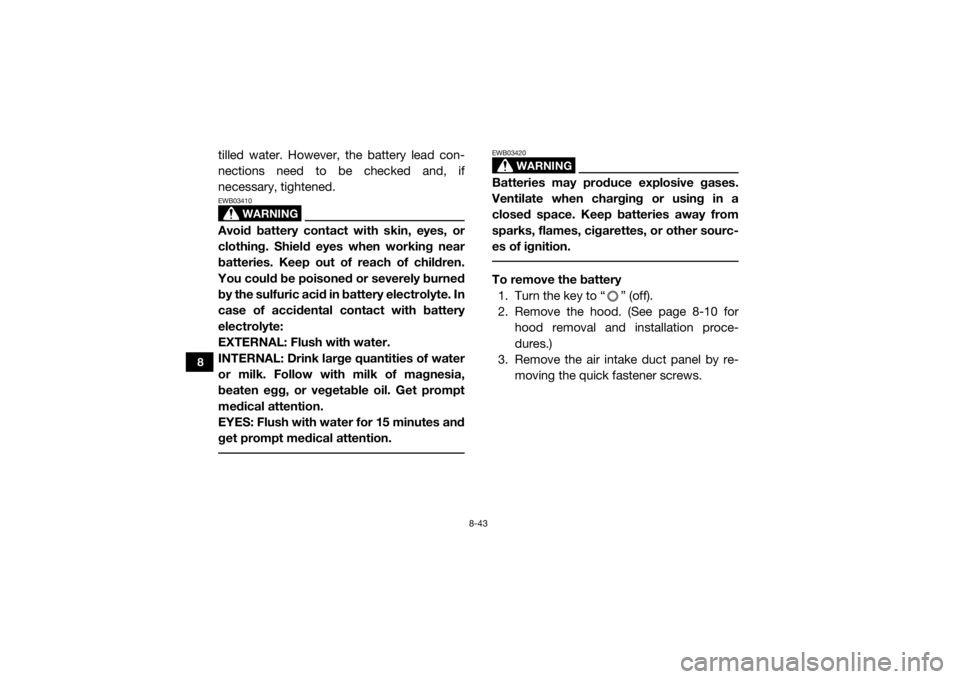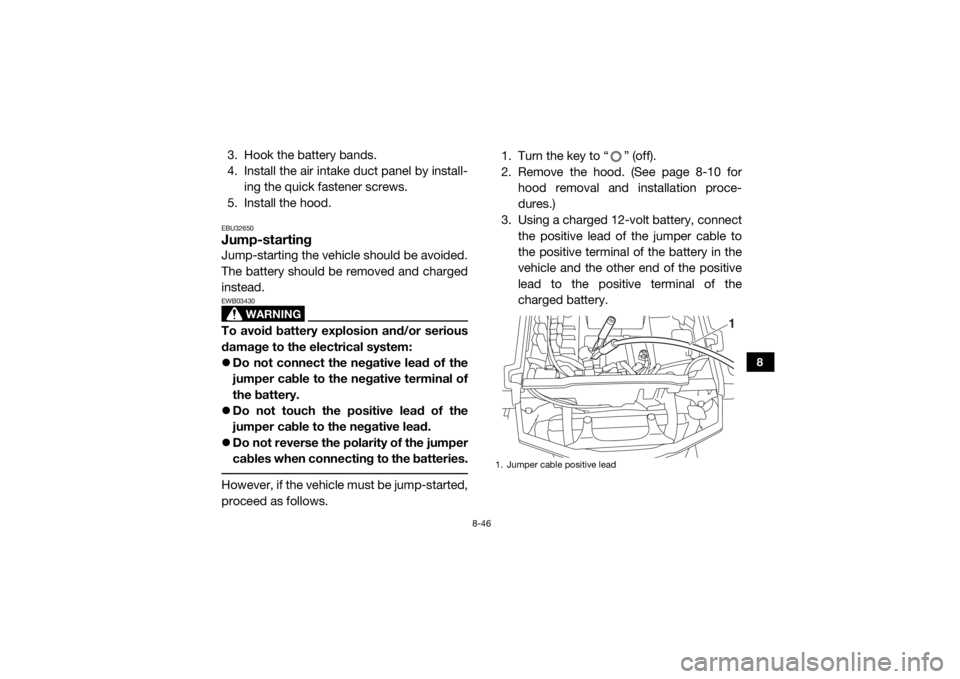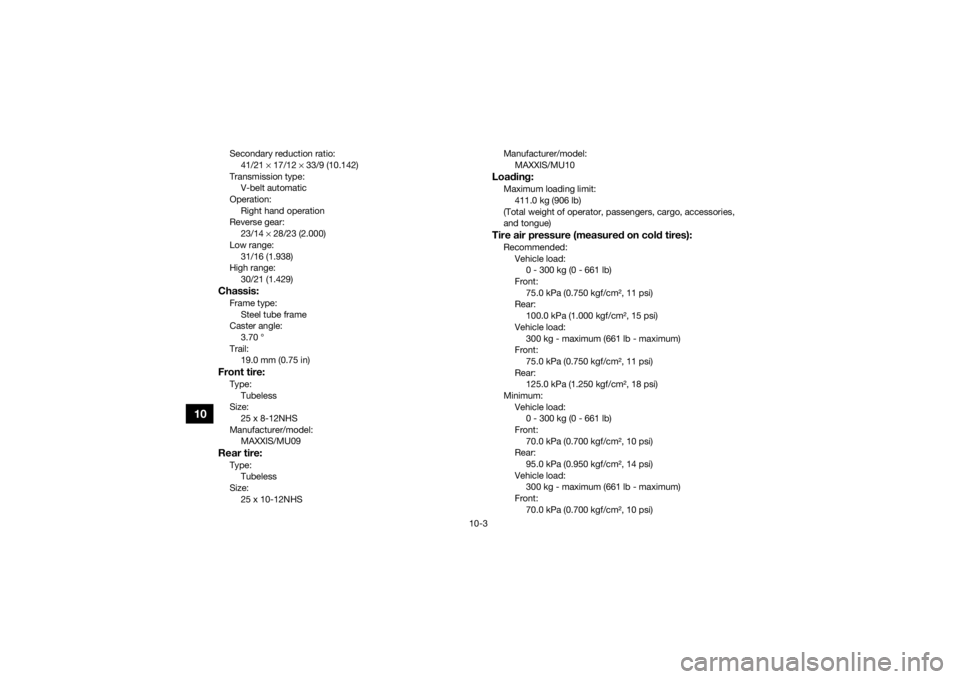Page 118 of 172
8-19
8
EBU36060Differential gear oilCheck the oil level and change the differential
gear oil at the intervals specified in the gener-
al maintenance and lubrication chart.
Checking the differential gear oil level1. Park the vehicle on a level surface.
2. Remove the differential gear oil filler bolt and its gasket, and then check the oil lev-
el. It should be up to the brim of the filler
hole.
3. If the level is low, add sufficient oil of therecommended type to raise it to the
specified level. NOTICE: Be sure no for-
eign material enters the differential
gear case.
[ECB00412]
4. Check the gasket for damage, and re- place it if necessary.
5. Install the differential gear oil filler bolt and its gasket, and then tighten the bolt
to the specified torque.1. Differential gear oil filler bolt
2. Gasket
3. Differential gear oil
4. Correct oil level
1
2
3
4
UB427BE0.book Page 19 Friday, February 5, 2016 2:14 PM
Page 140 of 172
8-41
8
EBU32620Tire replacementAlways use the same size and type of tires
recommended in this owner’s manual. The
tires that came with your Yamaha Viking were
designed to match the performance capabili-
ties and to provide the best combination of
handling, braking, and comfort. It is best to
replace all four tires at the same time. If that is
not possible, you must replace the tires inpairs (front or rear) with tires of the same size
and type as the originals. Never replace just
one tire.
WARNING
EWB03390Installing improper tires on your Yamaha
Viking can affect handling and stability.
This can cause a loss of control. The tires listed below have been approved by
Yamaha Motor Manufacturing Corporation of
America for this model.
1. Wheel nut
1
1
Front tire: Size:25 x 8-12NHS
Manufacturer/model: MAXXIS/MU09
Rear tire: Size:25 x 10-12NHS
Manufacturer/model: MAXXIS/MU10
UB427BE0.book Page 41 Friday, February 5, 2016 2:14 PM
Page 141 of 172
8-42
8
EBU33030Wheel installation1. Install the wheel and the nuts.TIPFor YXM70VPXH / YXM70VPHH: tapered
nuts are used for both the front and rear
wheels. Install the nuts with their tapered side
towards the wheel. YXM70VPXH / YXM70VPHH2. Lower the vehicle so that the wheel is on the ground. 3. Tighten the wheel nuts in a crisscross
pattern to the specified torque.
WARNING
EWB03400Do not reverse the rims on your Yamaha
Viking to widen the track width. Installing
wheels improperly increases the risk of
wheel failure and accidents. EBU32640BatteryThe battery is located under the hood. (See
page 8-10 for hood removal and installation
procedures.)
This model is equipped with a VRLA (Valve
Regulated Lead Acid) battery. There is no
need to check the electrolyte or to add dis-
1. Tapered nut
1
Tightening torques:Front wheel nut:75 Nm (7.5 m·kgf, 54 ft·lbf)
Rear wheel nut: 75 Nm (7.5 m·kgf, 54 ft·lbf)
UB427BE0.book Page 42 Friday, February 5, 2016 2:14 PM
Page 142 of 172

8-43
8
tilled water. However, the battery lead con-
nections need to be checked and, if
necessary, tightened.
WARNING
EWB03410Avoid battery contact with skin, eyes, or
clothing. Shield eyes when working near
batteries. Keep out of reach of children.
You could be poisoned or severely burned
by the sulfuric acid in battery electrolyte. In
case of accidental contact with battery
electrolyte:
EXTERNAL: Flush with water.
INTERNAL: Drink large quantities of water
or milk. Follow with milk of magnesia,
beaten egg, or vegetable oil. Get prompt
medical attention.
EYES: Flush with water for 15 minutes and
get prompt medical attention.
WARNING
EWB03420Batteries may produce explosive gases.
Ventilate when charging or using in a
closed space. Keep batteries away from
sparks, flames, cigarettes, or other sourc-
es of ignition. To remove the battery
1. Turn the key to “ ” (off).
2. Remove the hood. (See page 8-10 for hood removal and installation proce-
dures.)
3. Remove the air intake duct panel by re-
moving the quick fastener screws.
UB427BE0.book Page 43 Friday, February 5, 2016 2:14 PM
Page 145 of 172

8-46
8
3. Hook the battery bands.
4. Install the air intake duct panel by install-ing the quick fastener screws.
5. Install the hood.EBU32650Jump-startingJump-starting the vehicle should be avoided.
The battery should be removed and charged
instead.
WARNING
EWB03430To avoid battery explosion and/or serious
damage to the electrical system:
Do not connect the negative lead of the
jumper cable to the negative terminal of
the battery.
Do not touch the positive lead of the
jumper cable to the negative lead.
Do not reverse the polarity of the jumper
cables when connecting to the batteries. However, if the vehicle must be jump-started,
proceed as follows. 1. Turn the key to “ ” (off).
2. Remove the hood. (See page 8-10 for
hood removal and installation proce-
dures.)
3. Using a charged 12-volt battery, connect the positive lead of the jumper cable to
the positive terminal of the battery in the
vehicle and the other end of the positive
lead to the positive terminal of the
charged battery.
1. Jumper cable positive lead
1
UB427BE0.book Page 46 Friday, February 5, 2016 2:14 PM
Page 146 of 172
8-47
8
4. Connect the negative lead of the jumpercable to the negative terminal of the
charged battery and the other end of the
negative lead to an unpainted metal sur-
face of the frame of the vehicle to be
started.
5. Start the engine. (Refer to “Starting the engine” on page 6-2.)
6. After the engine starts, disconnect the
negative lead of the jumper cable from
the frame and charged battery, and then disconnect the positive lead of the jump-
er cable from the charged battery and the
battery in the vehicle.
7. Install the hood.
EBU33100Fuse replacementThe main fuse, the fuel injection system fuse,
the EPS fuse, and the fuse box are located
under the hood. (See page 8-10 for hood re-
moval and installation procedures.)
1. Jumper cable negative lead
1
UB427BE0.book Page 47 Friday, February 5, 2016 2:14 PM
Page 148 of 172
8-49
8
NOTICEECB00641To prevent accidental short-circuiting,
turn off the main switch when checking or
replacing a fuse. 2. Remove the hood. (See page 8-10 forhood removal and installation proce-
dures.)
3. Remove the blown fuse, and then install a new fuse of the specified amperage.
WARNING! Always use a fuse of the specified amperage. Never use any
material in place of the proper fuse.
Using an improper fuse can cause
damage to the electrical system and
may lead to a fire.
[EWB03440]
Specified fuses: Main fuse:40.0 A
Fuel injection system fuse: 10.0 A
Headlight fuse: 15.0 A
Ignition fuse: 10.0 A
Auxiliary DC jack fuse: 10.0 A
Signaling system fuse: 10.0 A
Four-wheel-drive motor fuse: 10.0 A
Radiator fan motor fuse: 25.0 A
Backup fuse: 10.0 A
EPS fuse: 40.0 A
UB427BE0.book Page 49 Friday, February 5, 2016 2:14 PM
Page 162 of 172

10-3
10
Secondary reduction ratio:41/21 × 17/12 × 33/9 (10.142)
Transmission type: V-belt automatic
Operation:
Right hand operation
Reverse gear: 23/14 × 28/23 (2.000)
Low range: 31/16 (1.938)
High range:
30/21 (1.429)Chassis:Frame type:Steel tube frame
Caster angle:
3.70 °
Trail: 19.0 mm (0.75 in)Front tire:Type:
Tubeless
Size: 25 x 8-12NHS
Manufacturer/model: MAXXIS/MU09Rear tire:Type:Tubeless
Size: 25 x 10-12NHS Manufacturer/model:
MAXXIS/MU10
Loading:Maximum loading limit:
411.0 kg (906 lb)
(Total weight of operator, passengers, cargo, accessories,
and tongue)Tire air pressure (measured on cold tires):Recommended:
Vehicle load: 0 - 300 kg (0 - 661 lb)
Front:
75.0 kPa (0.750 kgf/cm², 11 psi)
Rear: 100.0 kPa (1.000 kgf/cm², 15 psi)
Vehicle load: 300 kg - maximum (661 lb - maximum)
Front:
75.0 kPa (0.750 kgf/cm², 11 psi)
Rear: 125.0 kPa (1.250 kgf/cm², 18 psi)
Minimum: Vehicle load: 0 - 300 kg (0 - 661 lb)
Front: 70.0 kPa (0.700 kgf/cm², 10 psi)
Rear:
95.0 kPa (0.950 kgf/cm², 14 psi)
Vehicle load: 300 kg - maximum (661 lb - maximum)
Front: 70.0 kPa (0.700 kgf/cm², 10 psi)
UB427BE0.book Page 3 Friday, February 5, 2016 2:14 PM